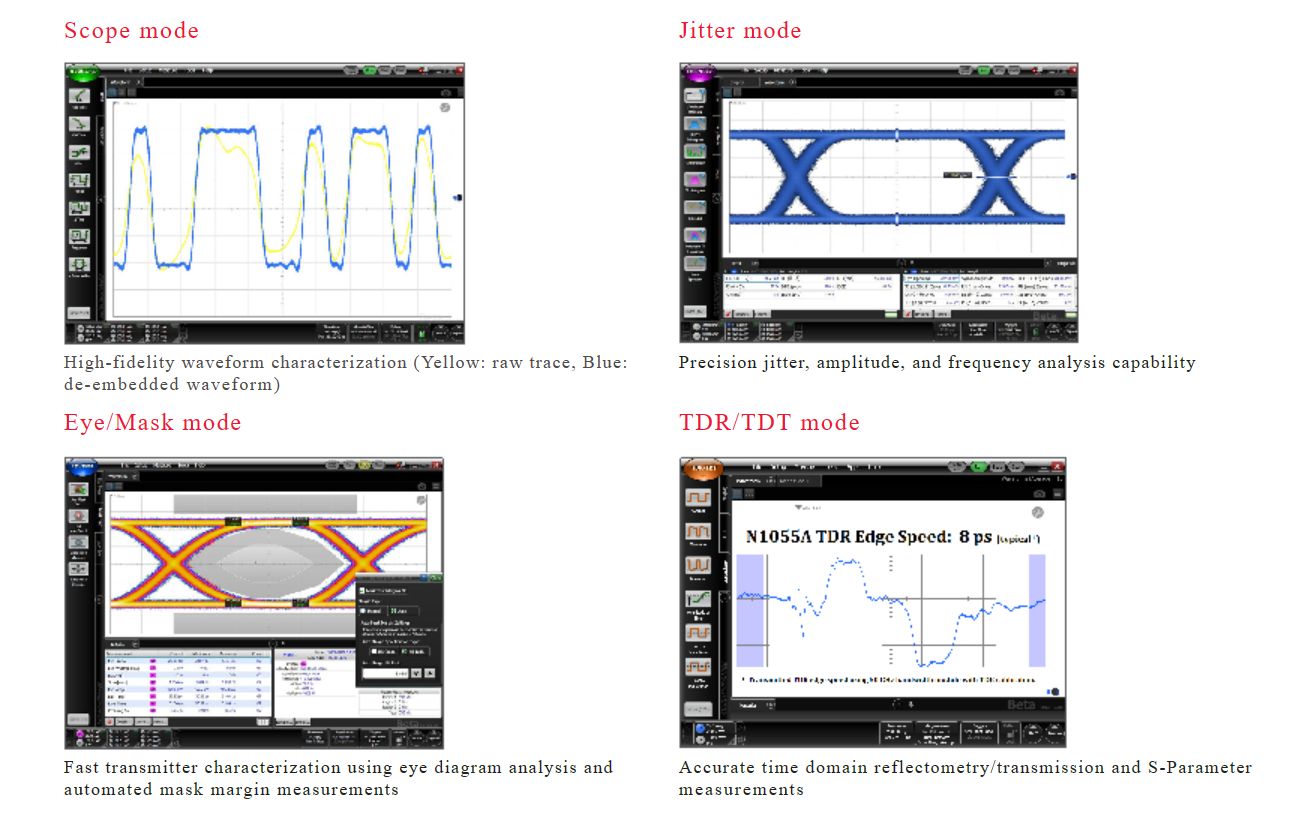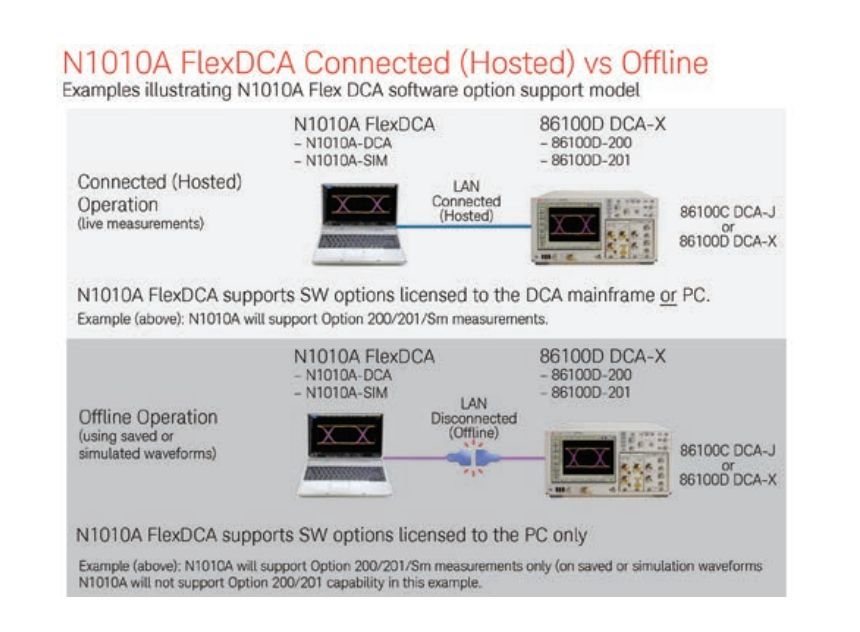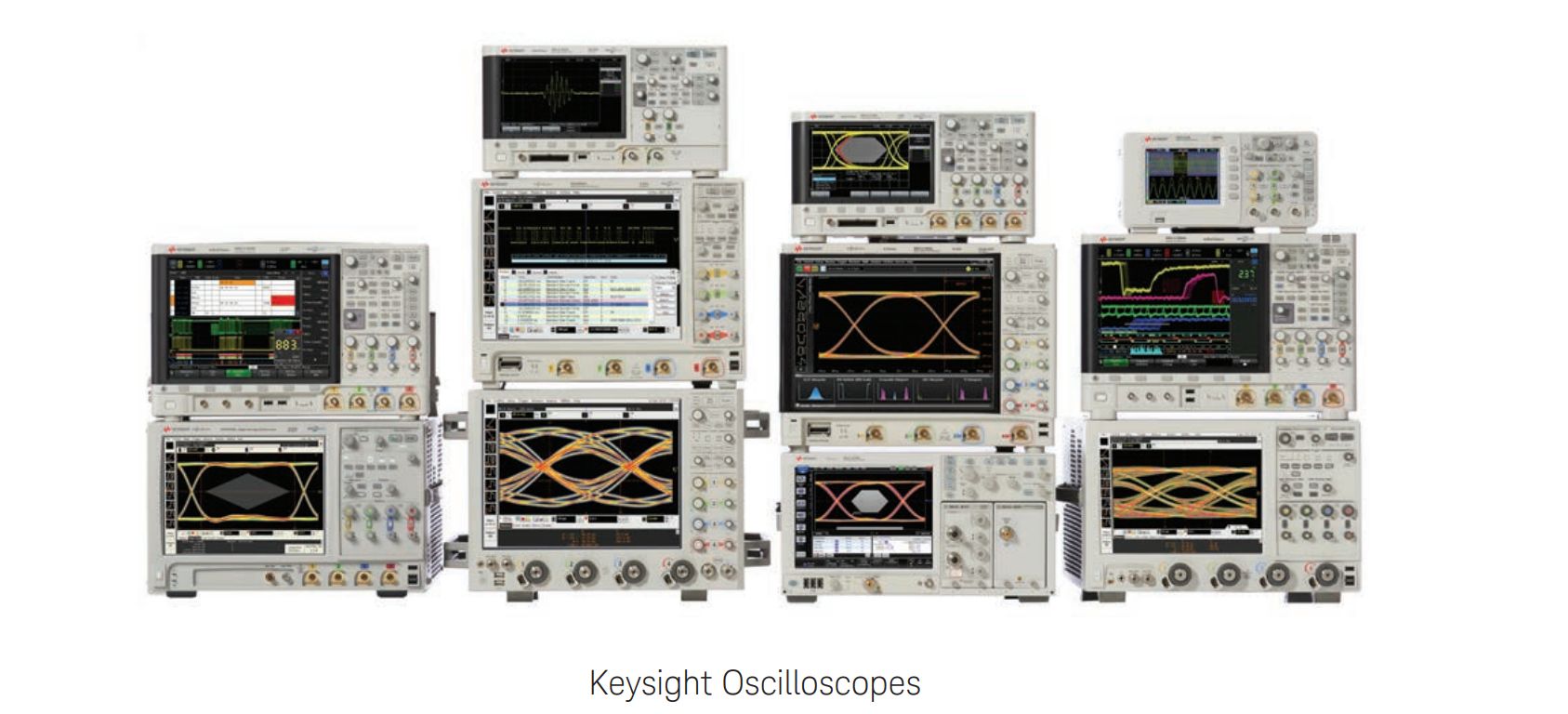Keysight 86100D How to use 86100D Oscilloscope Mainframe?
To use the 86100D oscilloscope mainframe, you need to do the following:
- First of all, you need to choose a suitable module, such as 86105C, to work with 86100D oscilloscope mainframe for testing and analyzing optoelectronic signals. Different modules have different bandwidths, input ports and functions, you can choose them according to your testing needs.
- Secondly, you need to install the module in the slot of 86100D oscilloscope mainframe and make sure the connection between the module and the mainframe is firm. You can see the module model and status on the oscilloscope screen.
- Then, you need to connect the signal source to the input port of the module and select the appropriate fiber type, wavelength, voltage range and impedance. You can use the buttons on the oscilloscope panel or the touch screen to make the settings.
- Next, you need to power on the oscilloscope and press the AUTOSETUP button on the module panel to let the oscilloscope automatically set the optimal trigger, time base and vertical parameters. You can also manually adjust these parameters to optimize the signal display.
- Finally, you can observe the waveform of the signal on the oscilloscope screen and use the menu options of the oscilloscope to perform time-domain measurements, spectrum analysis, eye diagram analysis, and other functions. You can also save, print, or export test data and images.
The 86100D is a wide bandwidth oscilloscope host that can be connected to a computer in different ways. You can choose from the following connection methods:

- LAN Connection : You can connect the LAN port of the 86100D to the LAN port of your computer using a network cable, or through a router or switch. You need to set the appropriate IP address and subnet mask on the 86100D and computer for communication. The SCPI server function also needs to be turned on on the 86100D in order to receive remote programming commands. SCPI commands can be sent to the 86100D over the LAN using the FlexDCA software or other software that supports VISA.
USB Connection : A USB cable can be used to connect the 86100D's USB port to the computer's USB port. Keysight IO Libraries Suite software needs to be installed to recognize the 86100D and assign a VISA address. SCPI commands can be sent to the 86100D via USB using FlexDCA software or other VISA-enabled software.
- GPIB Connection : If the 86100D has the GPIB option, a GPIB cable can be used to connect the 86100D's GPIB port to the computer's GPIB card or converter. The appropriate GPIB addresses need to be set on both the 86100D and the computer in order to communicate. Different programming guides and command sets will also need to be selected depending on the configuration mode (standard or legacy) of your 86100D. SCPI commands can be sent to the 86100D via GPIB using FlexDCA software or other VISA-enabled software. We hope you find this information helpful.

Keysight 86100D-9FP PAM-N analysis software. The software provides comprehensive optical and electrical PAM-4 signal analysis to help engineers use the Keysight 86100D DCA-X oscilloscope platform to perform fast and accurate PAM-4 (4-level pulse amplitude modulation) signal testing and verification.
In the information age, data center network bandwidth is under constant pressure as people demand rich content and fast access. These demands cannot be met by simply increasing component speeds. PAM-4 is multilevel signaling designed to increase the amount of data transferred over high-speed digital communication links. For example, PAM-4 is designed to support Ethernet speeds from 100Gb to 400Gb.
Several industry organizations and standards bodies are applying or actively considering the adoption of PAM-4 technology to enable next-generation speeds and increased data rates for a given channel bandwidth compared to traditional non-return-to-zero (NRZ) signaling. Traditional NRZ measurement algorithms can be partially used in PAM-4 testing, but the unique characteristics of PAM-4 signaling require specific algorithms, as well as specific parameter measurements.

The 86100D-9FP PAM-N analysis software provides the following measurements:
Eye width, eye height and eye chart offset
Level amplitude, level noise and level offset
Amplitude level linearity
The PAM-4 option can be combined with existing DCA-X software options to provide even more powerful analysis capabilities:
PAM-4 Equalizer (LFE, CTLE, DFE) in combination with 86100D option 201
PAM-4 Channel embedding/de-embedding, combined with 86100D option SIM InfiniiSim-DCA
IEEE JP03 pattern jitter and amplitude analysis, combined with 86100D option 200/300
To use the 86100D oscilloscope mainframe, you need to do the following:
- First of all, you need to choose a suitable module, such as 86105C, to work with 86100D oscilloscope mainframe for testing and analyzing optoelectronic signals. Different modules have different bandwidths, input ports and functions, you can choose them according to your testing needs.
- Secondly, you need to install the module in the slot of 86100D oscilloscope mainframe and make sure the connection between the module and the mainframe is firm. You can see the module model and status on the oscilloscope screen.
- Then, you need to connect the signal source to the input port of the module and select the appropriate fiber type, wavelength, voltage range and impedance. You can use the buttons on the oscilloscope panel or the touch screen to make the settings.
- Next, you need to power on the oscilloscope and press the AUTOSETUP button on the module panel to let the oscilloscope automatically set the optimal trigger, time base and vertical parameters. You can also manually adjust these parameters to optimize the signal display.
- Finally, you can observe the waveform of the signal on the oscilloscope screen and use the menu options of the oscilloscope to perform time-domain measurements, spectrum analysis, eye diagram analysis, and other functions. You can also save, print, or export test data and images.
The 86100D is a wide bandwidth oscilloscope host that can be connected to a computer in different ways. You can choose from the following connection methods:

- LAN Connection : You can connect the LAN port of the 86100D to the LAN port of your computer using a network cable, or through a router or switch. You need to set the appropriate IP address and subnet mask on the 86100D and computer for communication. The SCPI server function also needs to be turned on on the 86100D in order to receive remote programming commands. SCPI commands can be sent to the 86100D over the LAN using the FlexDCA software or other software that supports VISA.
USB Connection : A USB cable can be used to connect the 86100D's USB port to the computer's USB port. Keysight IO Libraries Suite software needs to be installed to recognize the 86100D and assign a VISA address. SCPI commands can be sent to the 86100D via USB using FlexDCA software or other VISA-enabled software.
- GPIB Connection : If the 86100D has the GPIB option, a GPIB cable can be used to connect the 86100D's GPIB port to the computer's GPIB card or converter. The appropriate GPIB addresses need to be set on both the 86100D and the computer in order to communicate. Different programming guides and command sets will also need to be selected depending on the configuration mode (standard or legacy) of your 86100D. SCPI commands can be sent to the 86100D via GPIB using FlexDCA software or other VISA-enabled software. We hope you find this information helpful.

Keysight 86100D-9FP PAM-N analysis software. The software provides comprehensive optical and electrical PAM-4 signal analysis to help engineers use the Keysight 86100D DCA-X oscilloscope platform to perform fast and accurate PAM-4 (4-level pulse amplitude modulation) signal testing and verification.
In the information age, data center network bandwidth is under constant pressure as people demand rich content and fast access. These demands cannot be met by simply increasing component speeds. PAM-4 is multilevel signaling designed to increase the amount of data transferred over high-speed digital communication links. For example, PAM-4 is designed to support Ethernet speeds from 100Gb to 400Gb.
Several industry organizations and standards bodies are applying or actively considering the adoption of PAM-4 technology to enable next-generation speeds and increased data rates for a given channel bandwidth compared to traditional non-return-to-zero (NRZ) signaling. Traditional NRZ measurement algorithms can be partially used in PAM-4 testing, but the unique characteristics of PAM-4 signaling require specific algorithms, as well as specific parameter measurements.

The 86100D-9FP PAM-N analysis software provides the following measurements:
Eye width, eye height and eye chart offset
Level amplitude, level noise and level offset
Amplitude level linearity
The PAM-4 option can be combined with existing DCA-X software options to provide even more powerful analysis capabilities:
PAM-4 Equalizer (LFE, CTLE, DFE) in combination with 86100D option 201
PAM-4 Channel embedding/de-embedding, combined with 86100D option SIM InfiniiSim-DCA
IEEE JP03 pattern jitter and amplitude analysis, combined with 86100D option 200/300







